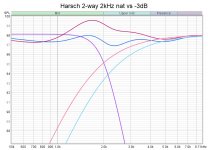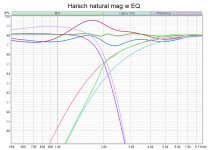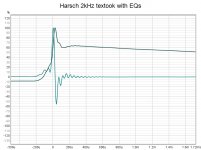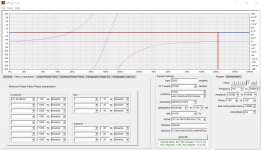Thanks BYRTT for looking it carefully. My measurements were ruined by DC offset in the soundcard reference channel and had to do some tricks to clean them up.Did all the measurements before noticing it, many hours of work (large speaker, hard work to conduct full spinorama 🙂 Also there is some highpass filter at 30hz in the simulation.
FIR has to wait, current prototyping setup doesn't have support for it but in few years I might have. These measurements are from spring 2019, have been sinking all free time and money to house renovation the whole 2020. I'm hoping to finish this stereo set this winter and then try and make some multiple entry horns. Slow progress 😀
FIR has to wait, current prototyping setup doesn't have support for it but in few years I might have. These measurements are from spring 2019, have been sinking all free time and money to house renovation the whole 2020. I'm hoping to finish this stereo set this winter and then try and make some multiple entry horns. Slow progress 😀
Hi Byrtt,
Hope your foot recovers and you feel better soon! These simulations that you did are great - so maybe I can try to see if moving the XO point a tad bit higher will do the trick. I am doing it all passively and trying to minimize components, so I have way more wiggles natively in the response vs a DSP implementation. Also, need to sort of take whatever closest slope I get. However, it seems to resemble a Harsch quite well. I just picked up my revised PTT6.5/RS28F WG TL cabinets from my cabinet maker this morning. They are sealed with PL Premium this time so guaranteed not to be leaky anymore. I installed a double set of wires in them so that I can remeasure the raw driver responses in-situ (vs surrogate cabinet). Hopefully the inclusion of the TL based ZMA file will produce a more accurate simulation.
I looked at reviews of the KEF 150 - that looks like a sweet speaker with coaxial driver that should be devoid of vertical lobing in polars. I believe KEF often uses 1st order XO from what I have seen of XO internals (KEF 100 coaxial speaker) posted by Matytinman.
Why does it work? Crossover with RF ferrite (wires) and 10nF polystyrene (bypass)
Hope your foot recovers and you feel better soon! These simulations that you did are great - so maybe I can try to see if moving the XO point a tad bit higher will do the trick. I am doing it all passively and trying to minimize components, so I have way more wiggles natively in the response vs a DSP implementation. Also, need to sort of take whatever closest slope I get. However, it seems to resemble a Harsch quite well. I just picked up my revised PTT6.5/RS28F WG TL cabinets from my cabinet maker this morning. They are sealed with PL Premium this time so guaranteed not to be leaky anymore. I installed a double set of wires in them so that I can remeasure the raw driver responses in-situ (vs surrogate cabinet). Hopefully the inclusion of the TL based ZMA file will produce a more accurate simulation.
I looked at reviews of the KEF 150 - that looks like a sweet speaker with coaxial driver that should be devoid of vertical lobing in polars. I believe KEF often uses 1st order XO from what I have seen of XO internals (KEF 100 coaxial speaker) posted by Matytinman.
Why does it work? Crossover with RF ferrite (wires) and 10nF polystyrene (bypass)
Last edited:
Hi BYRTT, sorry to hear health has been a problem, but glad to hear it's on the improve.
Your post re textbook -4.2dB vs -3dB helped me to begin to understand the BT high pass options in the q-sys processor (like mentioned in #726).
It appears what is termed 'natural magnitude' in q-sys gives the bessel textbook summation at -4.2dB.
And that "-3 dB mirror magnitude" gives the same result you showed for -3dB in your simulations.
Cool to know the "natural mag" optionappears to be textbook. Thx.
Here's some playing around I did that you guys might find of interest.....
After trying to smooth the textbook Harsch at 2kHz magnitude response with EQ's on the outputs post xover,
I noticed the resulting bessel high pass post EQ looks like a blend between the -4.2dB and -3dB versions.
Let me explain:
This first graph is the same thing you showed in your animation.
2-way Harsch at 2kHz textbook -4.2dB vs -3dB summations at xover
-3dB set: sum=dark red, HP=light red
-4.2dB set: sum=dark blue, HP=light blue
same BW4 LP for both sets=purple.

Nothing new so far, and not near as cool as your animation 🙂
Now with the EQed set:
sum=dark green, HP=light green
BW4 with EQ=light purple
(this is the -4.2dB set with 3-4 small EQ's on each side, none over +1dB)

Notice how the bessel high pass looks like it follows the -3dB HP until the xover point,
then head towards the textbook -4.2dB bessel below xover point.
I dunno, but i find that interesting as heck, and have no clue why.
I figure if anybody knows why, it's probably you 😀
Oh, and do you have a good reference on the various bessel implementations?
Your post re textbook -4.2dB vs -3dB helped me to begin to understand the BT high pass options in the q-sys processor (like mentioned in #726).
It appears what is termed 'natural magnitude' in q-sys gives the bessel textbook summation at -4.2dB.
And that "-3 dB mirror magnitude" gives the same result you showed for -3dB in your simulations.
Cool to know the "natural mag" optionappears to be textbook. Thx.
Here's some playing around I did that you guys might find of interest.....
After trying to smooth the textbook Harsch at 2kHz magnitude response with EQ's on the outputs post xover,
I noticed the resulting bessel high pass post EQ looks like a blend between the -4.2dB and -3dB versions.
Let me explain:
This first graph is the same thing you showed in your animation.
2-way Harsch at 2kHz textbook -4.2dB vs -3dB summations at xover
-3dB set: sum=dark red, HP=light red
-4.2dB set: sum=dark blue, HP=light blue
same BW4 LP for both sets=purple.

Nothing new so far, and not near as cool as your animation 🙂
Now with the EQed set:
sum=dark green, HP=light green
BW4 with EQ=light purple
(this is the -4.2dB set with 3-4 small EQ's on each side, none over +1dB)

Notice how the bessel high pass looks like it follows the -3dB HP until the xover point,
then head towards the textbook -4.2dB bessel below xover point.
I dunno, but i find that interesting as heck, and have no clue why.
I figure if anybody knows why, it's probably you 😀
Oh, and do you have a good reference on the various bessel implementations?
Mark, it would be interesting to see frequency and phase, as well as the IR after these tweaks 🙂.
Here you go Ron,
Slightly different EQ's and the impulse has an added Lpf at 20kHz that the SPL and phase traces don't.
I've found i need it to remove what I call digital gack from impulses,
when trying to make measurement across digital platforms.
Maybe that's what all the word clock stuff is about? Beats me so far...
Slightly different EQ's and the impulse has an added Lpf at 20kHz that the SPL and phase traces don't.
I've found i need it to remove what I call digital gack from impulses,
when trying to make measurement across digital platforms.
Maybe that's what all the word clock stuff is about? Beats me so far...
Attachments
That looks really good, Mark. Nice work! So maybe what we should be aiming for are the EQ'd shapes you show vs textbook? Or maybe that is sort of what happened by accident when I got the passive Harsch with the PTT6.5 and RS28 in WG300?
Loaded in the new DSP settings. Not sure if it is the different frequency response or the phase thing or something else but the sound seems to get out from the speaker a bit better with the Harsch xo. Sound is a bit more held back with the more traditional xover I posted few days ago.
The vertical frequency response variation isn't as dramatic as I thought it would be so this can stay in the module for now. Have to compare again some other day 🙂
The vertical frequency response variation isn't as dramatic as I thought it would be so this can stay in the module for now. Have to compare again some other day 🙂
Many thanks warm wishes guys, health will fortunate improve soon but probably im so behind in life and diyA that it will take some time be really back here, heck i bought some KEF Q150 months ago (recieved in april) and i havent had time and energy hear them yet before their new journey where coxial arrays will get canabilized to build some diy stuff.
cheers and have a best day.
I, too, have been worried not seeing you around lately. I was about to PM you and others to find out why.
Get back on your two feet as soon as possible, still doing what you love.
Speedy recovery!
That looks really good, Mark. Nice work! So maybe what we should be aiming for are the EQ'd shapes you show vs textbook? Or maybe that is sort of what happened by accident when I got the passive Harsch with the PTT6.5 and RS28 in WG300?
Thx xrk971 !
Yeah, my vote is to EQ the textbook Harsch to flat...
to at least get electrical xover flat, to be able to start with a clean sheet before I bring the drivers into the act.
I doubt it was by accident, your nice results with the passive Harsch ..
It still amazes me how folks have learned to juggle passives with drivers and get the results they do 🙂
@ xrk971
I guess I may not be alone here with my interest in horizontal (and vertical if possible) directivity patterns of your successful design. Do you think that may be possible to do for you?
Thanks and Regards,
Winfried
I guess I may not be alone here with my interest in horizontal (and vertical if possible) directivity patterns of your successful design. Do you think that may be possible to do for you?
Thanks and Regards,
Winfried
I, too, have been worried not seeing you around lately. I was about to PM you and others to find out why.
Get back on your two feet as soon as possible, still doing what you love.
Speedy recovery!
Thousand thanks perceval, it took sixteen months so far and soon wil be recovered and be back down the road, good thing is had never been in danger and get 100% recovered, so compared folks that land in a wheelchair or so other crisis for the rest of their life one is a lucky person.
@ xrk971
I guess I may not be alone here with my interest in horizontal (and vertical if possible) directivity patterns of your successful design. Do you think that may be possible to do for you?
Thanks and Regards,
Winfried
I only have horizontal polars - more info in this thread:
Simple Passive Harsch XO Using PTT6.5 and RS28F in a Waveguide
They are quite nice, basically no variation within 60deg included angle.
I have not measured vertical but I don’t seem to hear any anomalies with my head movement. It must have some lobing though being a non-coaxial design.
I have the waveguide underneath the woofer and listen on the woofer axis or slightly above. I think this gives a wider sweet spot.
The big delay in your setup is between the sub and the mid so yes physically moving the sub would remove the need for the digital delay. Having them 1.72m apart might look a little weird?
As to the acoustic coupling at the crossover I can't say but if they are vertically aligned and only moved in or out then the physical distance is the same as time delay, you are changing the effective acoustic centre the same amount with both.
I think this can be got away with at 100Hz, especially with your steep crossovers but you would have to try it out to be sure.
Yep, if the vertical spacing were pretty tight, for at least on-axis, delay vs distance shouldn't matter.
Although any distance spacing has to amplify off-axis variations.
With PA work, I've found when subs get separated from mains past 1/4WL, about all that can be done is pick a spot in the audience and time to it.
Just the way it is, huh?
One thing I've yet to find a solution for...is how to get a steep xover at 100Hz with latency low enough for live sound, or any situation that can't tolerate much latency.
IIR doesn't work well past 4th order imo, although sometimes i have used up to 8th when sub to main distance is excessive. Group delay is group delay...
Linear phase needs at least 40ms latency at 100Hz to hold 12th order well ime, and double that latency for every octave downward.
I'm all ears for a solution...but i really don't believe it's possible...
Everything tried keeps coming back to "it takes time to fix time" 😉
.....I'm all ears for a solution...but i really don't believe it's possible...
Everything tried keeps coming back to "it takes time to fix time" 😉
Harsch isn't steep enough and what is distance, get below using 500mm distance and a +1dB gain for LF section, simulation use audioband 20Hz-20kHz homebrew perfect omni transducers hor/ver is covered with 72x 10º per step inputs so what we see in curves is isolated the cause by filters and spacing excluding the directivity of a real world transducer..
A mouse click into animation will hinder X/Y ratio distortions:
Attachments
Last edited:
I can get good agreement linearizing the phase only of an LR96 at 100Hz with 4096 taps which is about 46ms latency.One thing I've yet to find a solution for...is how to get a steep xover at 100Hz with latency low enough for live sound, or any situation that can't tolerate much latency.
IIR doesn't work well past 4th order imo, although sometimes i have used up to 8th when sub to main distance is excessive. Group delay is group delay...
Linear phase needs at least 40ms latency at 100Hz to hold 12th order well ime, and double that latency for every octave downward.
I'm all ears for a solution...but i really don't believe it's possible...
Everything tried keeps coming back to "it takes time to fix time" 😉
Attached is the best I can do with LR8 at 100Hz, 15ms latency and fairly good match to the phase wrap without wrecking the magnitude response.
No free lunch with FIR filters and changing phase 🙂
Attachments
Mark,
how steep do your slopes have to be ? Why do you need more than fourth order for the subs ?
Regards
Charles
how steep do your slopes have to be ? Why do you need more than fourth order for the subs ?
Regards
Charles
please forgive what is probably a dumb question... Although I remember doing fourier and laplace transforms at university 34 years ago, I don't remember any of the details. My understanding of signal processing theory is limited...
What would be the result of an LR4 crossover where the high frequency driver was delayed by one full period? A textbook LR4 has a 360 degree phase lag between the LF and HF drivers... so what happens if the HF unit is delayed by 360 degrees?
For example, a 2 kHz LR4 crossover where the HF unit is delayed by 1/2000 = 0.5 ms... my simple minded thinking suggests that this would result in a properly blended step function, but with the advantages of a flat summed response.
Common sense tells me that if this were a workable solution, it would have been done before... so what am I missing?
What would be the result of an LR4 crossover where the high frequency driver was delayed by one full period? A textbook LR4 has a 360 degree phase lag between the LF and HF drivers... so what happens if the HF unit is delayed by 360 degrees?
For example, a 2 kHz LR4 crossover where the HF unit is delayed by 1/2000 = 0.5 ms... my simple minded thinking suggests that this would result in a properly blended step function, but with the advantages of a flat summed response.
Common sense tells me that if this were a workable solution, it would have been done before... so what am I missing?
Great questions Charles,
They are about the only questions I keep asking myself with regard to linear phase and steep xovers
Because i can pretty easily measure the effects on polars for xovers higher than 100Hz, and am convinced of their improvements.
But 100Hz is tough for me to measure polars, even outdoors.
One thing i need to mention that's probably a little unique about my setup is that i keep an easily adjustable volume control on each section of my 4-ways.
There is an individual slider for sub, mid, hf, and vhf......all controlled by a master volume (digitally controlled amplifier DCA slider)
Sections are all reasonably close to the same number of octaves in width, and I've found this makes for the best tone control setup I've experienced.
Almost any track can be made to sound tonally balanced pretty quickly, if desired.
We all know if we raise the level of one section vs another we change acoustic xover, and normally most likely screw up the polars of all our hard earned tuning.
But with steep complimentary, i find acoustic xover shifts very little,
and stays in phase (especially since that it took linear phase xovers to get usable steep to begin with.)
But back to subs...
Again, harder to measure all this...
So I rely more on listening...
And keep coming to...When sub xover is steeper, it's been easier to maintain a tight punchy, non-bloated bass sound, as I raise the sub level relative to the rest of the spectrum.
If it weren't for this, I'd just go with LR4's or something..
They are about the only questions I keep asking myself with regard to linear phase and steep xovers
Because i can pretty easily measure the effects on polars for xovers higher than 100Hz, and am convinced of their improvements.
But 100Hz is tough for me to measure polars, even outdoors.
One thing i need to mention that's probably a little unique about my setup is that i keep an easily adjustable volume control on each section of my 4-ways.
There is an individual slider for sub, mid, hf, and vhf......all controlled by a master volume (digitally controlled amplifier DCA slider)
Sections are all reasonably close to the same number of octaves in width, and I've found this makes for the best tone control setup I've experienced.
Almost any track can be made to sound tonally balanced pretty quickly, if desired.
We all know if we raise the level of one section vs another we change acoustic xover, and normally most likely screw up the polars of all our hard earned tuning.
But with steep complimentary, i find acoustic xover shifts very little,
and stays in phase (especially since that it took linear phase xovers to get usable steep to begin with.)
But back to subs...
Again, harder to measure all this...
So I rely more on listening...
And keep coming to...When sub xover is steeper, it's been easier to maintain a tight punchy, non-bloated bass sound, as I raise the sub level relative to the rest of the spectrum.
If it weren't for this, I'd just go with LR4's or something..
- Home
- Loudspeakers
- Multi-Way
- S. Harsch XO



